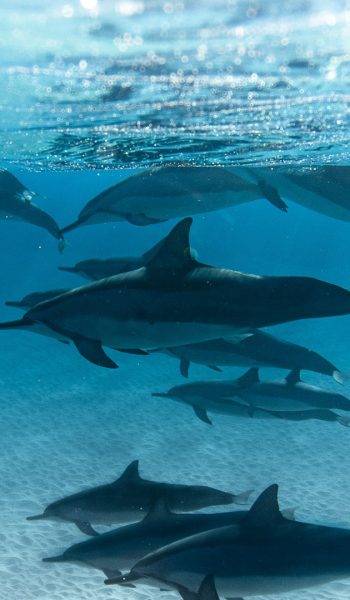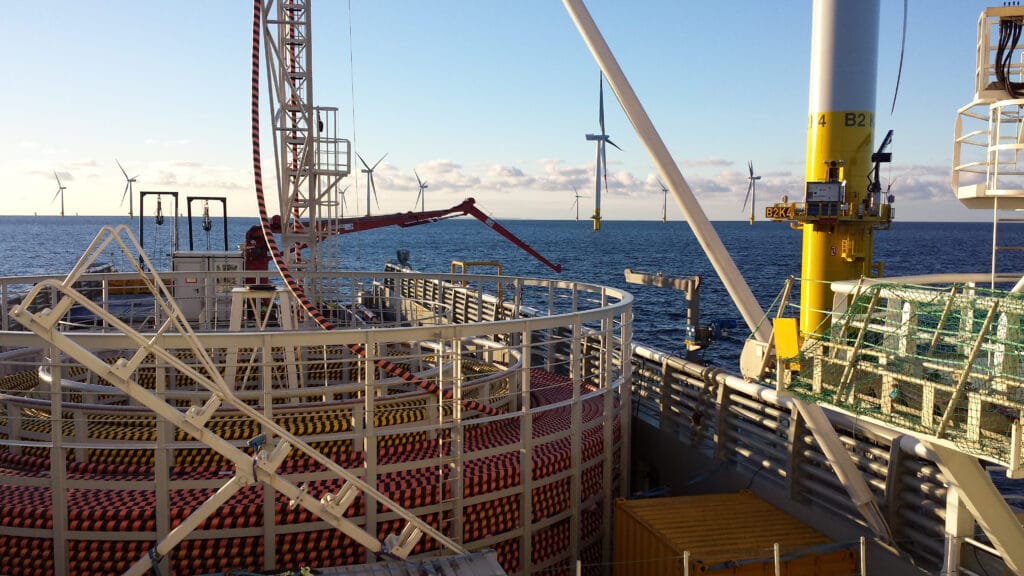Encouraging the use of offshore wind farms as a source of renewable energy is an important step toward becoming a greener, more sustainable world and fight climate change. While offshore wind farms are a big step in this direction, the development of this potential energy source can have negative environmental effects on marine life and its ecosystem. In this article, we will explore the sources and impacts that offshore wind farms have on underwater species.
But first, what is offshore wind energy?
Offshore wind energy is an alternative way to generate electricity that helps to reduce fuel and carbon dioxide emissions when producing energy, both harmful for the environment.
In offshore wind farms (OWF), the electricity is harvested by way of wind turbines or windmills that convert the kinetic energy of the wind into electrical energy. The wind farm turbines are installed in areas of open water, where there are far less barriers, so the wind blows stronger and more consistently and thus creating more energy.
Wind farms are usually located in shallow waters, approximately 20 km away from the coast, with an average depth of 30 m. However, choosing the right place to set up a wind farm may depend on various factors, such as the depth of the water, wind, and the sea floor, as well as environmental disruptions to marine species living in that area.
Your environmental monitoring at your fingertips!
Optimize your environmental monitoring, become smarter and more sustainable with a unified system that gathers all your environmental sensors & data in one place.

Sources and impacts of offshore wind farms on the marine habitat
Offshore wind farms have a big impact on underwater pollution. From their construction to their deployment, offshore wind farms, with their turbines and metallic foundations, generate noise and vibrations below the sea surface (called “anthropogenic noise” because it is unnatural and human-made) that disturb marine life and flora, especially for the underwater mammals that rely on sound (like echolocation or vocalization) to survive in the ocean.
We can identify several sources and effects derived from offshore wind farms that can have an impact on marine life:
1. Wind turbine vibration
Wind turbines are significant contributors to noise pollution as they cause underwater acoustic vibrations that are transmitted at low-frequency noises though the water. Although the windmill’s blades are above the surface, the vibrations go down the mast and into the base closer to the seabed, thus introducing a new source of noise pollution in the water. These sounds can interfere with marine mammals’ behaviors, as it alters their way of communicating, feeding, reproducing, and navigating the oceans. On some occasions, these changes can lead to injury or even death.
The impacts of underwater noise pollution on marine life can vary from species to species and long-term effects are yet to be confirmed, as there isn’t much data available, or many studies conducted on this problematic.
2. Construction site activites

The bulk of noise pollution events occurs when wind turbines are installed in the ocean. Certain construction activities —such as pile driving, wedging, and increased vessel traffic— include the use of heavy machinery that emit noise vibrations when installing the wind turbines’ foundations and other offshore platforms, as well as securing the power cables (which conduct the energy back to the mainland) to the sea floor.
The effects of offshore wind farm construction activities will differ among species. For some, construction areas might interfere with marine mammals’ navigation routes or disrupt the fishes and other marine animals’ natural habitat and drive them away. Furthermore, they can alter the construction area as pile driving used to lock turbine foundations in place can affect the sea floor ecosystem, forcing many native species away. Amongst other impacts, anthropogenic noise can also cause permanent hearing damage in fish and risk of collision and spatial displacement in other species, such as turtles.
3. Electromagnetic fields
The underwater power cables carry the renewable energy from the offshore wind farms to the mainland grid emit electromagnetic fields (EMFs.) These artificial magnetic fields can interfere with, and even mask, the natural EMFs present in the ocean. Certain fishes and marine mammals are more sensitive than other species to this natural magnetic compass, which allows them to navigate their environment to search for food, communicate, stay orientated and migrate, locate resources and predators, etc.
When the ocean’s natural EMFs are disrupted by OWFs, some changes in behaviors were observed in fish and other marine mammals, particularly those with a higher affinity to detect power cables or fish that move closer to the ground. For example, studies have shown that species like skates and rays displayed shifts in their exploratory and foraging behavior when in proximity to an EMF. Eels were shown to be able to cross over a cable but slowed down; fish such as salmon smolts could pass a cable EMF in the migration route, but a degree of misdirection was detected.
4. Metal pollution

Offshore wind farms are constructed on piles upon piles of metallic structures. Seawater is a powerful corrosive agent and prolonged exposure can cause the introduction of pollutants into the underwater environment. A less known consequence of installing offshore wind farms below the sea is that the metal foundations’ corrosion can change the quality of the water, and this can lead to fish poisoning as substances and chemicals are released into the water.
5. Artificial reef effect
The construction of offshore wind farms can lead to a phenomenon known as “artificial reef effect” in which, if a wind farm is closed to fishing or is less frequented, an effect similar to a nature reserve can occur. A negative impact is that invasive species can find home in these new habitats in the artificial reefs and become a harmful environmental influence. On the other hand, the protections put in place in the wind farms’ foundations to avoid this very issue can lead to new habitats that compensate for the lost one, but they will depend on the nature and location of the reef and the characteristics of the marine population.
Your environmental monitoring at your fingertips!
Optimize your environmental monitoring, become smarter and more sustainable with a unified system that gathers all your environmental sensors & data in one place.

Conclusion about how offshore wind affect marine life
Although wind energy and offshore wind farms can have beneficial impacts on the environment, as seen in this article, they can still present negative effects as construction and operation activities in at sea can disrupt the life of underwater species and its ecosystem. It is therefore important to keep monitoring the impacts of offshore wind farms so that we can better understand and protect our oceans.
Frequently Asked Questions About: Offshore Wind Farm & Marine Pollution
Underwater noise is bad because it harms marine animals by preventing them from hearing natural ocean noises, pushing them away from their natural habitat, and even changing their migration patterns. This in turn impacts the ocean environment and natural ecosystem.
Human activities such as shipping, sonars, construction activities such as dredging, platforms, drilling and installing oil rig platforms, as well as seismic surveys contribute to underwater noise pollution.
Underwater noise pollution can be prevented with innovative technologies and Artificial Intelligence, such as the Sea Life Module on Sinay’s IT platform, the Sinay Hub.
An alternative way to generate electricity. This way of producing electricity take the wind and convert it in electricity
Different sources and impacts:
- Wind turbine vibration
- Construction site activities
- Electromagnetic fields
- Metal pollution
- Artificial reef effect





